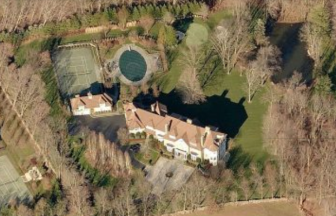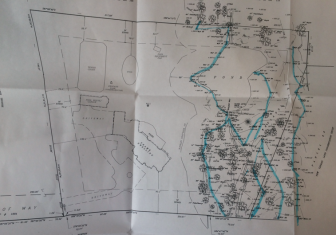Town officials say they need a more detailed landscaping plan for a West Road property after discovering recently that vegetation around a pond had been removed without permissions—the second time that Inland Wetlands violations had been found on the 5.57-acre parcel.

Aerial of 559 West Road in New Canaan
Michael Platt, assistant manager of the property at 559 West Road, told the Inland Wetlands Commission at its meeting on Monday night that he thought it was OK to remove what he called small forsythia and other bushes from around the pond that had dried out and died.
Platt said his plan had been to replant the area and he realized after speaking to municipal workers that he “should not have done that.”
“So I do apologize,” Platt said during a public hearing, held in the Town Hall Meeting Room. “It was kind of a new ambition in the new job to try and remove the dead plants and foliage and put in new stuff.”
He added that he thought because the pond was manmade, it may be exempt from the regulations—it is not, as bodies of water “natural or artificial” are defined as watercourses under the Inland Wetlands and Watercourses Regulations (see page 7 here).

The original plan for planting at 559 West Road. Hoffman Landscapes
Commissioners raised the prospect of fining the property’s owners—a suggestion that the staff members who make such decisions said they would take under advisement.
Purchased for $7.1 million in December 2013, the property at 559 West Road includes a 15,000-square-foot house as well as a tennis court and pool, tax records show. The pond lies toward the northeast corner of the property, abutting a half-acre property that’s owned by the New Canaan Land Trust.
There, in an extensive clearing that included the Land Trust parcel, the property’s owners had committed an initial violation last fall, when they removed all vegetation from wetlands and an upland review area without the commission’s permission.
That clearing and trespass issue was discovered this spring and Land Trust officials who spoke at Monday’s hearing said they’re satisfied with a planting plan that’s been proposed by landscape architects hired by the homeowners, and believe that first violation was accidental.
The Land Trust over the summer reviewed an application for restoration there that had been prepared in July by Wilton-based Hoffman Landscapes. The Hudsons, who own the West Road property, committed a violation under Inland Wetlands regulations when Platt did the clearing around the pond while its formal application from July was pending.
Ultimately, the Inland Wetlands Commission voted on Monday to put off a decision on approving a plan for the property until details are in hand about just what will be done around the pond.
“This is the second violation and I think it would be good for us to know how this occurred and what the full process is to remedy,” said Commission Secretary Angela Jameson, acting as chairman for the meeting.
Commissioners asked whether Platt had been aware of the prior violation (no), whether pond water was being used to irrigate other parts of the property (no), whether he knows the homeowner’s intentions for the plantings around the pond area (not yet) and whether he had any plans given to him when he took over the role about three weeks ago (no).
Tracy Chalifoux, a landscape architect with Hoffman, in addressing the question of what was planned for the cleared area abutting and including the Land Trust property, said invasive vegetation and vines that are strangling trees would be removed.
“Another part of this proposed application is a 2-rail split rail fence along the property line that separates the Land Trust and [homeowner’s] properties,” Chalifoux said. “And the planting layout was adjusted slightly to move some of the proposed trees toward that fence line, creating a sort of visual boundary between the two properties where before there was no visible boundary along that property line.”
Chalifoux added that the landscaping plan for the area had been amended—for example, reducing the number of proposed trees from 40 to 12 and shrubs from 71 to 56—as a result of meeting with the Land Trust this summer.
New Canaan Land Trust President Chris Schipper said the properties are positioned in an unusual way that makes it understandable that property lines were not clear to the Hudsons.
He also said that the Hudsons “have been very accommodating with issue of habitat restoration.”
“It isn’t often people come back and say, ‘We will give you planting plan to help restore what was there.’ ”
Schipper added: “I would say from the Land Trust perspective, we are comfortable with this plan and delighted with the split-rail fence, which will give a good visual barrier to it and our hope is that the Land Trust continues in a very positive and neighborly fashion with all our neighbors. And we do appreciate the fact that sometimes our neighbors encroach and then tell us what a good job they did and don’t listen to our concerns about restoration, and in this case we feel like we worked in a pretty neighborly manner.”
Jameson told Chalifoux that the commission had questions about what would be planned for the landscaping around the pond.
Though Chalifoux stopped short of committing to a plan—she told the commissioners that she planned meet with the homeowners the following day—she added that “typically what I would recommend for this type of restoration would be shrubs, a minimum of three feet tall, native wetland plants—in this case, they would have to have some deer resistance—a pretty substantial buffer around the entire perimeter of the pond and maybe some ferns in shadier areas and other native perennials.”
Commissioner Barbara Wilson commended Chalifoux for the plan for the meadow, but said she was concerned about a proposed berm for one end of the pond.
“My concern is that the hemlocks in there are going to have to be sprayed for deer, the spruce and hemlock may or may not take this much water so you will have to raise them up, so effectively you are creating a dike or berm that is going to affect the water flow from the northern property to this property and totally change characteristics of this,” Wilson said. “So I have a great concern about what is going to happen, especially if in a few years all these trees die after you have planted them. What is going to happen? That is my fear. I know you are responding to your client’s wishes. I am still not in favor of this.”
Asked by Jameson whether she had considered alternatives to a berm of such size, Chalifoux said: “We briefly considered a mix of taller shrubs but we did not think we could achieve the privacy that the homeowners were looking for, the screening to walking along that right of way.”